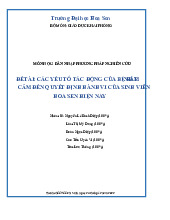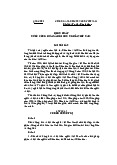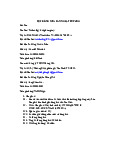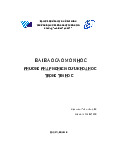



Preview text:
QUANTITATIVE RESEARCH & QUALITATIVE RESEARCH APPROACH
IS THE DEBATE BETWEEN THEM A NEVER-ENDING ONE?
Nguyen Luong Hoang Thanh, M.A. INTRODUCTION
People have questioned, observed, analyzed, hypothesized, and evaluated for years to make sure that the result
of educational research can enhance the process of teaching and learning. And among many approaches to
educational research, there has been heated debate as well as broad classification among the academic
community about the relative merits of quantitative and qualitative research approach. Although the boundaries
may be difficult to determine as both approaches have their own advantages when people make the most and
best use of their findings; the debate tackling which method is better than the other, seems to never end.
LITERATURE REVIEW OF TERMS
As for Dörnyei (2007), quantitative research involves data collection procedures that result primarily in
numerical data which is then analyzed primarily by statistical methods. On the other hand, qualitative research
involves data collection procedures that result primarily in open ended or non numerical data which is then
analyzed primarily by non statistical methods. According to Fraenkel, Wallen, and Hyun (2011), in the simplest
sense, quantitative data deals primarily with numbers, whereas qualitative data primarily involves words.
Picciano (2004, as cited in Bray, Adamson, and Mason, 2007) also provides a simple comparison of quantitative
and qualitative research methods in education. He defines quantitative research as relying on the collection of
numerical data which is then subjected to analysis using statistical routines, and qualitative research, by contrast,
relies on meanings, concepts, context, descriptions, and settings. In other words, quantity refers to amounts,
while quality refers to the essence of things. Based on the origins of the two approaches, Charoenruk (2006) has
described “quantitative research” as a process of observations and measurements which can be made objectively
and repeated by other researchers. It is the early form of the two and originates in the natural sciences such as
biology, chemistry, physics, geology, etc. The research which attempts to increase our understanding of why
things are the way they are in our social world and why people act the way they do is called “qualitative
research. This is the later form and helps in social sciences such as psychology, sociology, anthropology, etc.
Next, I would like to discuss the main characteristics of the two approaches introduced by Dörnyei (2007). As
for quantitative research, the most important feature of this research is that it is centered around numbers.
Second, because the use of numbers already dominates the data collection phase, the work required to specify
the categories and values need to be done prior to the actual study. Third, in contrast to the qualitative emphasis
on the individual case, quantitative research is centered around the study of variables that capture common
features and which are quantified by counting, scaling, or by assigning values to categorical data. Next, statistics
and the language statistics play a significant role in quantitative research because there is a close link between
quantitative research and statistics. Then, quantitative research pays much attention to standardize research
procedures to ensure that they remain stable across investigators and subjects. And finally, quantitative research
follows a quest for generalizability and universal laws. Talking about qualitative research, the first
characteristic is emergent research design. This means that no aspect of the research design is tightly prefigured
and a study is kept open so that it can respond flexibly to new details or openings that may emerge during the
investigation. As for the data, qualitative research works with a wide range of data including recorded
interviews, various types of texts and images. Next is the characteristic of the research setting: because of the
qualitative objective to describe social phenomena as they occur naturally, qualitative research takes place in the
natural setting. As for the inside meaning, qualitative research is concerned with subjective opinions,
experiences and feelings of individuals and thus the explicit goal of research is to explore the participants’ views
of the situation being studied. One more thing is that qualitative studies use much smaller samples of
participants than quantitative ones. And finally, qualitative research is fundamentally interpretive, which means
that the research outcome is ultimately the product of the researcher’s subjective interpretation of the data. In
other words, the researcher is also the measurement device. 153
WHAT ARE THE DIFFERENCES?
Nunan (1992, as cited in Burns, 1999) points out some basic differences between qualitative and quantitative
research as follows: while quantitative research adopts a structured and standardized approach towards their
enquiries, qualitative researchers think that this approach is too scientific and mechanistic, therefore, argue for
an alternative frame of reference, one that involves understanding the research context from inside. Talking
about the purpose, while quantitative research aims at testing hypotheses, looking at cause and effect and
making predictions; the aim of qualitative approaches is to offer descriptions, interpretations, and clarifications
of naturalistic social contexts. Thus, in contrast to formulating, testing and confirming or disconfirming
hypotheses, qualitative research draws on the data collected by the researcher to make sense of the human
behavior within the research context. In quantitative research, because experimental approach offers clear
definitions and controls of variables, studies can be replicated and comparisons made across different studies
and sites. The qualitative researcher, on the other hand, treats the context as it occurs naturalistically and no
attempt is made to control the variables in the context. Observation and description and the gathering of data
from a range of different resources are the main methodological tools. The emphasis is on “rich” data collection
and then interprets them through “thick” description and analysis. Finally, they do not attempt to make claims
about generalizing the findings of the research to large populations as in quantitative research.
As for Dörnyei (2007), the two paradigms contrast in three points: first is “categorizing the world” (quantitative
research often predetermines numerical category system while qualitative research has emergent and flexible
verbal coding), next is “perceiving individual diversity” (quantitative research uses large samples to iron out any
individual idiosyncrasies while qualitative research focuses on the unique meaning carried by individual
organisms), and the last one is about “analyzing data” (while quantitative research relies on the formalized
system of statistics, qualitative research bases on the researcher’s individual sensitivity).
More recently, Fraenkel at al. (2011) has provided more detailed comparisons. In their opinion, quantitative and
qualitative methods differ in their assumptions about the purpose of research itself, methods utilized by
researchers, kinds of studies taken, the role of the researcher, and the degree to which generalization is possible.
Quantitative researchers usually base their work on the belief that facts and feelings can be separated, that the
world is a single reality made up of facts that can be discovered. Qualitative researchers, on the other hand,
assume that the world is made up of multiple realities, socially constructed by different individual views of the
same situation. When talking about the purpose of research, quantitative researchers seek to establish
relationships between variables and look for and sometimes explain the causes of such relationships. Qualitative
researchers, on the other hand, are more concerned with understanding situations and events from the viewpoint
of the participants. Also discussing the aim of these two approaches, Dörnyei (2007) states that quantitative
research is seen to aim at achieving a macro – perspective of the overarching trends in the world, whereas
qualitative research is perceived to represent a flexible and highly context sensitive micro – perspective of the
everyday realities of the world. When it comes to the steps taken, quantitative research has established general
formulations of steps that guide researchers in their work. In other words, quantitative research designs tend to
be pre-established. Qualitative researchers, on the other hand, have a much greater flexibility in both the
strategies and techniques they use and the overall research process itself. Their designs tend to emerge during
the course of the research. What we should keep in mind is that the steps involved in conducting a qualitative
study are not as distinct as they are in quantitative studies. They often overlap and sometimes are even
conducted concurrently. Especially, while in quantitative researches, the drawing of conclusions is often left to
the end of the research, interpretations and conclusions are drawn continuously throughout the course of a
qualitative study. In qualitative research, the ideal researcher role is that of a detached observer, whereas
qualitative researchers tend to become immersed in the situations in which they do their research. Therefore, the
nature of reality in quantitative research is single and objective reality, and in qualitative research multiple and
subjective realities. Next, Fraenkel at al. (2011) also states that there are differences between two approaches to
data collection and analysis. Talking about this feature, Paltridge and Phakiti (2010) also claim that while in
quantitative research, the emphasis is on controlling variables to the extent that the influence of the researchers
is minimized, in qualitative research, the aim is to search for the richest possible data. The outcome needs to be
a thick description, which is a narrative of what has been found that shows the full complexity and depth of what 154
is going on. Lastly, most quantitative researchers want to establish generalizations that transcend the immediate
situation or particular setting. Qualitative researchers, on the other hand, often do not even try to generalize
beyond the particular situation.
IS THE DEBATE BETWEEN THESE TWO APPROACHES A NEVER-ENDING ONE?
Bryman 1998, Denzin and Lincoln 2000, Picciano 2004 (as cited in Bray et al., 2007) note that there are
disadvantages in both paradigms. Quantitative research is criticized for silencing voices, ignoring subjects’
perspectives, excluding meaning, focusing on theories which are irrelevant to research subjects themselves,
stripping away context from research questions, and only generating data which are superficial and inapplicable
to individual cases. Detractors of qualitative research criticize it for relying too much on the researcher’s
interpretations, producing findings which are not generalizable or replicable, generating “soft” data, and even
being an assault on truth. From the view of Burns (1999), some writers even argued that qualitative and
quantitative approaches are incompatible as they rest on different views of the status of knowledge and truth and
the nature of social behavior.
However, during the recent years, many people have depicted the two approaches as complementary, suggesting
that each approach can supplement and complement the other. Major and Savin-Baden (2010) is a typical
example. They think that qualitative research synthesis provides a different perspective on questions addressed
through quantitative approaches. Like meta-analytic researchers, synthesists generally derive their questions
from those that exist in the literature. By examining different questions and combining different sets of
evidence, synthesists can help provide even greater illumination of a topic, which may complement what
quantitative meta-analysis has revealed; therefore, the two approaches taken together could be powerful. Sharing
the same ideas, Bogdan and Biklen (2007, as cited in Fraenkel et al., 2011) state that there is no one best
method. It all depends on what you are studying and what you want to find out. There are certain questions and
topics that the qualitative approach will not help you with, and the same is true of quantitative research. The
important thing is to know what questions can best be answered by which method or combination of methods
(known as mixed method). In short, I would like to say that I myself quite agree with these above viewpoints.
Neither of these two broad approaches should be considered as superior to the other. Each of them takes a
different view of the nature of knowledge and has different goals and functions. What to keep in mind is that
different methods and procedures need to be selected according to the different kinds of purposes for undertaking the research. CONCLUSION
Research in general and educational research in particular are carried out ultimately to help people, and the fact
that linguists debate with each other on which approach is the best and should be used is not necessarily a bad
thing. As Fraenkel et al. (2011) has pointed out, it must be stressed that each of the research methodology has
value for us in education; each constitutes a different way of inquiring into the realities that exist within our
classrooms and schools and into the minds and emotions of teachers, counselors, administrators, parents, and
students. Therefore, each has its own strengths and weaknesses which actually vary depending on the topic the
researcher wants to discuss. For example, you should use quantitative research if the purpose is to find out the
answer to an inquiry through numerical evidence. In the event that you want to explain why some particular
event or phenomenon happens, then qualitative research should be your first choice. And even in some studies,
both quantitative and qualitative research can be used to complement each other. After all, it is the researcher’s
decision that much contributes to the success of every research. 155 REFERENCES
1. Bray, M., Adamson. B., & Mason. M. (Eds.). 2007. Comparative Education Research: Approaches and
Methods. New York: Springer.
2. Burns, A. 1999. Collaborative Action Research for English Language Teachers. Cambridge: CUP.
3. Charoenruk, D. 2006. Communication Research Methodologies: Qualitative and Quantitative
Methodology. Retrieved from:
http://utcc2.utcc.ac.th/localuser/amsar/PDF/Documents49/quantitative_and_qualitative_methodologies. pdf
4. Dörnyei, Z. 2007. Research Methods in Applied Linguistics. New York: OUP.
5. Fraenkel, J. R., Wallen, N. E., & Hyun, H. H. 2011. How to Design and Evaluate Research in
Education. 8th edition. Boston: McGraw – Hill.
6. Major, C. H. & Savin-Baden, M. 2010. An Introduction to Qualitative Research Synthesis: Managing
the Information Explosion in Social Science Research. London: Routledge.
7. Paltridge, B. & Phakiti, A. (Eds.). 2010. Continuum companion to research methods in applied
linguistics. Sydney: Continuum International Publishing Group. 156




